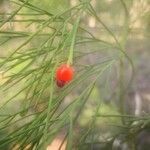Shrub or small tree to 8 m high with rounded or pyramidal crown, green or yellowish green. Bark tessellated, grey. Branchlets numerous, fine, striate, erect to pendulous. Leaves scale-like, thick, spreading, obtuse or acute, 0.5 mm long. Spikes to 6 mm long, mostly in uppermost axils; peduncle 1–2 mm long. Tepals 5, c. 0.3 mm long. Fruiting receptacle obovoid or ellipsoidal, 4–6 mm long, red; drupe ovoid or ellipsoidal, 4–5 mm long; tepals persistent.


